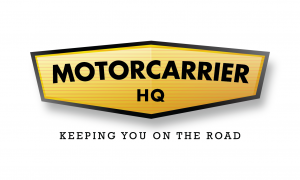October 10, 2023
A Guide to Improving Your CSA Score

Safe road behavior saves lives. And one of the most effective ways the trucking industry keeps the roads safe is by tracking driver behavior, data, and roadside incidents through something called a Compliance, Safety, and Accountability (CSA) score.
This number can impact your company’s success because it’s monitoring your company’s safety and once your score is captured, it is available to the public for anyone to see. More than anything, the CSA score keeps all of us accountable on the road. Read on to learn how you can improve it.
What is a CSA Score and Why Does it Matter?
A company’s CSA score measures how safe a motor carrier company is while the company’s drivers are out doing their job. It’s basically a safety score – like a grade you would get in school.
The Federal Motor Carrier Safety Administration (FMCSA) is the agency in charge of the enforcement program and every motor carrier has a CSA score. The company’s safety data will be updated on the FMCSA database once a month and the score reflects which carriers have safety issues and are violating the laws.
What Impacts a CSA Score?
Various safety data goes into a CSA score. The industry calls them Behavior Analysis and Safety Improvement Categories (BASICs). According to the FMCSA, BASICs are:
- Unsafe driving. This includes reckless driving, speeding, bad lane changes, not wearing a seatbelt, and not paying attention.
- Crash indicator. This includes the company’s history of being involved with crashes, the severity of the crash, and how often they happen.
- Hours-of-service (HOS) compliance. This includes not being compliant with federal HOS policies such as driving when tired or sick. You can also get in trouble for not maintaining the HOS logbook.
- Vehicle maintenance. This includes maintaining lights, signals, breaks, tires, mechanical defects, etc. If you don’t make repairs in a timely manner, this will definitely impact your CSA score – especially if one of these issues causes a crash.
- Controlled substances and alcohol. This is pretty cut and dry. If someone is under the influence, they are unfit to be behind the wheel.
- Hazardous materials compliance. This includes containers that leak, improperly packaging products, and not displaying appropriate signs or placards to alert people that you’re carrying hazardous material.
- Driver fitness. This includes a driver who doesn’t have proper driving or DCL credentials, a driver who is physically or medically unfit to be behind the wheel, and incomplete driver files.
How to Check a CSA Score?
It’s pretty easy to find out your current CSA score. Visit the CSA program’s website where you will enter your company’s name and DOT number. Most of the BASICs scores are public and motor carriers can log into the Safety Measurement System (SMS) to do a deeper dive into the score.
Because these are public, customers can view your company’s score at any time. It’s one reason why it’s imperative to maintain your safety reputation. Another bonus of having a lower CSA score: this could mean fewer audits from the U.S. Department of Transportation.
Is a High CSA Score Good?
The scores range from 0 to 100 and you want a low score – zero is best. Each violation assigns a certain number of points to your company. However, your score will increase by 1-10 points (yikes) if you get an entire category violation. This could happen anytime, so it’s good to check your score at least once a month. Check out this Motor Carrier HQ post to learn more about the points system.
How Can a Company Get a Better CSA Score?
The most common answer to improving your company’s CSA score is that it takes time and you need a few different solutions working together.
If you get a really bad CSA safety rating, you can’t drive or work anymore until you get it resolved. You really have to fail a lot of data points, though, to get a high score that’s closer to 100. And, anything higher than 50 is usually considered high alert.
Fortunately, there are a few things you can do to bring up your score:
-
Maintain accurate and up-to-date files.
Make sure you have complete driver files for each of your drivers. Take a look at some of the worst offenders and create a plan to offer them defensive driving training or ramp up giving them warnings, notices, and other consequences.
-
Routinely inventory your signage and placards.
Take inventory of your hazardous material placards, replacing or updating signs that could use a makeover.
-
Reevaluate your hiring practices.
Take a look at your hiring practices and strengthen your weak points. A driver you currently employ helped earn your company that bad score, so ask yourself about the holes in your hiring process. What hiring process did you cut corners on when you hired this driver?
It’s crucial you hire employees with good safety records. Using the Pre-Employment Screening Program (PSP) gives you access to a potential hire’s driving record over the past 3-5 years, and checking this ensures the hire is being honest about their driving behavior. Plus, companies that use PSP can lower their crash rate by at least 8%.
-
Be proactive (not reactive) about equipment maintenance.
Create a new way of going over equipment maintenance issues so less ‘fix-its’ fall through the cracks. Train drivers to notice and problem-solve mechanical issues as they arise. Even paying attention to the smallest fix-its such as low tire tread or broken lights can pay off. In fact, light issues make up at least 30% of roadside violations, so using a consistent ‘check it’ system is worthwhile.
-
Prioritize safety in your marketing efforts.
Establish a marketing campaign within your company that encourages safe driving behaviors such as wearing a seatbelt and not texting while driving.
-
Enforce regular drug and alcohol testing.
Test more frequently or randomly for drug and alcohol enforcement issues. Take an inventory of your current drug and alcohol program and research ways to improve it and the work culture around it.
Remember, if you get a warning letter, you still have a chance to do better. Use that information to take proactive steps that help lower your company’s safety risk. You don’t actually have to respond to the letter because FMCSA will continue to collect and monitor your safety data, but knowing your score needs improvement gives you a baseline.
The FMCSA states there are 5 million trucks that share the road with bus drivers and almost 250 million other drivers. With that amount of safety risk, it’s crucial to maintain a low CSA score. That’s why staying safe on the road is everyone’s job.


